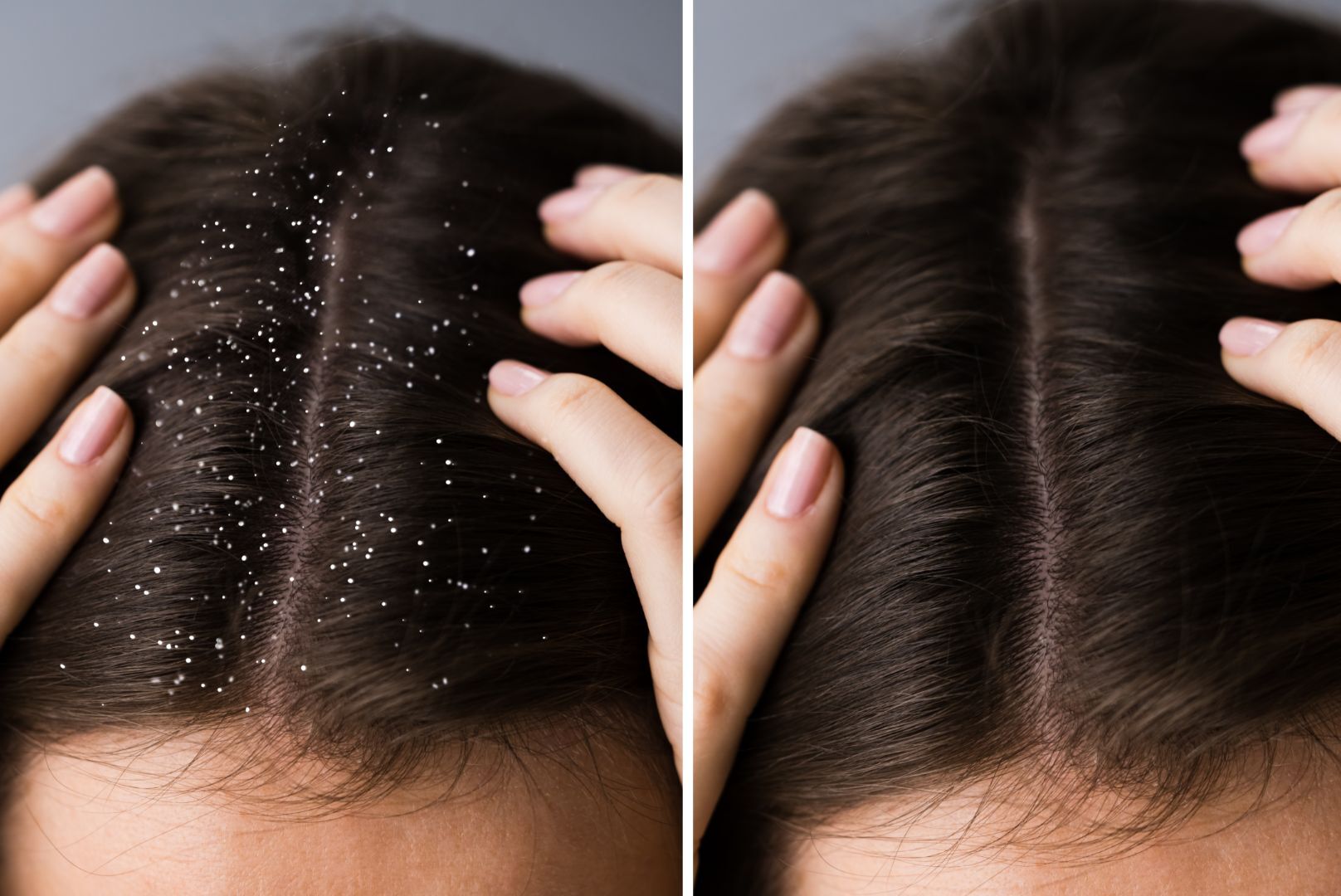

Picture this: It's Thursday night, your pulling your hair into a bun to cook dinner and your hands feel that all-too-familiar mix of oil and dry shampoo that has been keeping this blowout going since Monday. (Or was it Sunday?) We're all guilty of sometimes pushing wash day just a little too far, but sometimes that delay between cleanses can lead to scalp buildup.
And that is no easy task to get rid of. Don’t worry, we gathered the seven best ways to remove scalp buildup! Keep reading to learn all about it and give it a shot yourself…
What is Scalp Buildup?
Scalp buildup is the accumulation of “dirt” on hair and scalp from multiple origins, including sebum (oil) production, skin cells, hair products, airborne pollution, pollen, and even tobacco smoke. This buildup can impact the appearance and health of the scalp and hair.
While the sources of scalp buildup can be both natural (scalp oil production and normal skin cell shedding) and environmental (hair products, airborne pollution, pollen, and tobacco), the consequences are the same. The covering of the scalp by hair creates a unique skin surface microenvironment that facilitates microbial growth, leading to a unique microbiome. These microbes use components of the buildup as food sources which fuel their metabolic activity, enhancing their impact on the underlying skin. This can lead to conditions such as dandruff and seborrheic dermatitis, and potentially even hair loss.
It's often easy to see (and feel) scalp buildup when it occurs, but removing it isn't always that simple. If you have ever had the experience of washing your hair, but still not feeling like it's fully clean, scalp buildup was likely the culprit. Once formed, scalp buildup won't always wash away with your normal shampoo.
Understanding how scalp buildup can cause more serious damage than a bad hair day, we collected the following 7 steps on how to remove scalp buildup:
1. Wash More Frequently
Regular cleansing is the best way to prevent scalp buildup. It's also the first step in removing it. Scalp buildup is exactly what it sounds like: the accumulation of any kind of impurity like flakes—dead skin cells—or plaque on the scalp from natural or artificial sources, like haircare products. Luckily, she adds that both forms of buildup are very treatable—starting with more frequent cleansing.
If you’re noticing a lot of buildup, that could be your scalp’s way of telling you it’s gone too long without a cleanse. Depending on your hair type, your wash frequency will vary, but if you’re seeing buildup on a regular basis, it may be time to wash a bit more frequently.
If you have an oily scalp, it’s best to cleanse the scalp every day or every other day. If you have dry, damaged, or colored hair, then once every three to five days works best. The way you're washing and even the products you're using (more on this later) can also impact the efficacy of your hair washing.
2. Physically Exfoliate the Scalp
Just like we exfoliate the skin on our face, introducing exfoliation to our scalp is an important tool in controlling and ridding the scalp of buildup. Using a scalp brush when shampooing will allow you to gently physically exfoliate the buildup away from the scalp so that the shampoo can then wash it out of your hair.
You can also use your fingers to massage the scalp with your shampoo to try and physically remove the buildup, but be sure to use your finger pads instead of your nails. While scratching the scalp with your nails may feel good, it can actually cause damage to the skin barrier of the scalp and lead to further problems.
3. Chemically Exfoliate the Scalp
Depending on your level of buildup, chemical exfoliation may be helpful as a complement to or in lieu of physical exfoliation. It’s recommended to chemically exfoliate your scalp once to twice weekly. Try using a glycolic and salicylic acid spray to prevent or reduce buildup.
A combination of physical and chemical exfoliation can also work, but take caution to avoid over exfoliation as this too can contribute to flaking.
4. Use a Clarifying Shampoo
Many hair care products are designed to bind to your hair in order to give you the desired results, whether frizz reduction, strand-smoothing, or heat protection. Those same hair care products can also leave a residue on your skin, including your scalp, in turn causing buildup. When this happens, your normal shampoo may not be enough to clear the buildup.
This where using a clarifying shampoo to tackle buildup can be an option. There are many kinds of formulations, with certain ingredients being better for curly or damaged hair. No matter which one you select, use clarifying shampoo on wet hair focusing on the scalp. Make sure you rinse hair with water before adding shampoo for a more effective lather that spreads more evenly with less product and that the water should be warm to help loosen up dirt and debris.
5. Evaluate Your Current Products
Some ingredients are bad build-up culprits. Take silicones for example: Silicones are found in a lot of hair styling products that are designed to treat frizz or protect form heat because they coat the hair. This coating has the potential to build up on the scalp and contribute to the hair looking and feeling dirty.
Another serious culprit? Dry shampoo. A dry shampoo’s core purpose is to soak up oil to 'extend a wash.' In most cases, dry shampoos end up blocking the surface of the skin where your skin cells shed and sebaceous glands secrete oil. The dry shampoo functions as a blockade thereby prohibiting the natural and healthy skin turnover lifecycle. Dry shampoo is okay for occasional use (one to two times per week), but you need to thoroughly cleanse afterwards to ensure it has been fully removed from your scalp.
6. Get a Scalp Treatment
For those who may want to take a more relaxing approach to tackling their scalp buildup, there are plenty of in-office and spa treatments designed to treat this problem. Many spas and salons also offer scalp facials, scrubs, and even steam treatments to combat scalp buildup and leave the hair feeling super clean.
7. Use a Medicated Shampoo
If you have already tried addressing your buildup at home or start experiencing symptoms like burning or itching, it's time to consult a dermatologist to determine the cause. If you have tried washing regularly, using a clarifying shampoo, and minimizing products that can cause build up, and you still experience build up, seeing a dermatologist can help. If you have what feels like 'patches' of buildup, areas of scalp redness, large 'flakes' or significant itching it is best to see a dermatologist to rule out seborrheic dermatitis or another skin condition.
A common source of the buildup (and in turn itching, redness, or irritation) is overgrowth of a common-occurring fungus on your scalp called malassezia furfur. In a healthy scalp with normal skin, dead skin cells shed constantly as new ones grow. The sloughing off of dead skin cells usually goes unnoticed, the particles are tiny and the process doesn’t cause any visible flakes or irritation. The lifecycle of skin cells on the scalp is usually around a month. In people with dandruff, for example, this process happens at an accelerated rate and with more destructive results. An overgrowth of malassezia is commonly thought to be fueling this rapid skin growth cycle which in turn leads to buildup.
In these cases, a dermatologist will be able to determine the cause of your discomfort, and ultimately a treatment. A medicated shampoo may be the best course of treatment for conditions such as dandruff. Your dermatologist may prescribe a specific one, typically with zinc pyrithione.
The Takeaway
While many people will tell you they go days or even over a week without washing their hair, the fact is that scalp buildup and major flaking are a side effect of doing just that. So remember to wash your hair regularly, and consider scalp exfoliations and deep cleaning shampoos from time to time to help your hair out. For regular shampoo, steer clear from silicones and preservatives that can be too harsh and heavy on your scalp.
Wild Naturals shampoo and conditioner and made of natural ingredients and leave you with a clean, light-weight feel to your hair, no matter how thin or thick! Shop our online store today.


